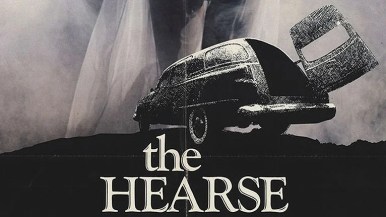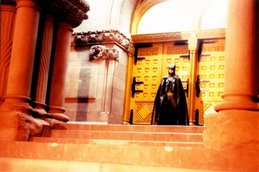Some movies slip through the cracks of horror history—not quite cult classics, not quite forgotten relics, but instead hovering in that strange purgatory where genre fans know of them without necessarily having seen them. The Hearse, directed by George Bowers, is exactly that sort of film.
On paper, The Hearse has all the makings of a gothic horror standout: an isolated old house with a tragic history, a small town with suspiciously nosy locals, a mysterious stranger who may or may not be a ghost, and, of course, the titular hearse, gliding down shadowy backroads like a rolling omen. But the actual film we get? Well, let’s just say the coffin lid doesn’t always shut tightly. The story follows Jane Hardy (Trish Van Devere), a recently divorced schoolteacher who retreats to the rural town of Blackford to spend the summer in her late aunt Rebecca’s house. From the start, Jane faces hostility from locals like attorney Walter Pritchard (Joseph Cotten), who claims the house should be his, and unsettling visions of both her aunt’s ghost and a phantom hearse that appears and vanishes without explanation.
Not to mention, nightmares that may be more than dreams.
Jane’s attempts to settle in are further complicated by strange nocturnal disturbances, Rebecca’s diary—which reveals her involvement with devil worship—and her budding romance with the enigmatic Tom Sullivan (David Gautreaux), who first appears after rescuing her from a car accident in his vintage black car. Though charming, Tom’s connection to Rebecca and the sinister events in town becomes increasingly suspicious, while Jane finds herself drawn deeper into the house’s dark history. Meanwhile, young handyman Paul Gordon (Perry Lang) develops his own attachment to Jane, only to be caught in the supernatural crossfire.
“Miss Hardy, have you ever heard of the term MILF?”
The final act confirms Jane’s worst fears: Rebecca had made a pact with Satan, and Tom is not only linked to her but may in fact be the same man—undead, Immortal, and bound to fulfill the pact through Jane. After the deaths of both Pritchard and Paul, Jane learns the truth and is nearly ensnared in Tom’s bargain before Reverend Winston (Donald Hotton) intervenes with an attempted exorcism. The climax escalates into a desperate chase as Tom pursues Jane in the hearse, ending in fiery destruction when it crashes and explodes off a cliff. Yet even in defeat, the evil lingers—Rebecca’s apparition watching from the darkened house, as though the pact has never truly ended.
Don’t worry, there will not be a sequel.
Stray observations:
•
If horror films have taught me anything, it’s that visiting your old
hometown will lead to nothing but trouble. Just ask Ben Mears about his
trip back to Salem’s Lot.
•
If on your first night in an old house, a music box plays by itself,
and is then not where you left it the following morning, pack your
things and get out. That’s just common sense.
• She’s run off the
road multiple times, someone breaks into her house, but she never calls
the police. And sure, the sheriff’s a creep, but you could at least file
a report.
• The film is practically allergic to speed — it takes
almost an hour before anything truly happens, making it feel like a
gothic horror trapped inside a real-estate dispute.
• Jane Hardy
spends more time wandering through her aunt’s house than anyone spends
wandering in Scooby-Doo. You start to think the real horror is poor
interior lighting.
• The townspeople are weirdly hostile to Jane from
the very first scene. Imagine moving to a small town and immediately
having everyone tell you to get lost — it’s like The Wicker Man, but with less music and more awkward silences.
•
Dennis Quaid shows up uncredited as a telephone repairman, and it had
me questioning whether this was a horror film or a porno.
“Did someone call for a hook-up?”
The strongest element here is the sense of mood. Bowers leans heavily into gothic trappings—foggy woods, candlelit hallways, a piano that seems to play by itself—and the titular hearse, a black, silent, almost sentient vehicle that stalks Jane at odd moments, works well as a recurring image. There are even flashes of Carnival of Souls in the way the hearse appears: sudden, spectral, inexplicable. When the film embraces its uncanny imagery, it has a kind of dreamy potency, the sense that Jane has stepped into a nightmare that obeys its own strange rules.
Safety Tip: Do not approach a hearse in your nightgown at night.
But atmosphere can only take a movie so far, and The Hearse too often mistakes slow-burn pacing for suspense. Scenes that should build tension tend to drag, and Jane spends a lot of the movie wandering, staring, or repeating the same cycle of being spooked, doubted, and dismissed. The “romantic” subplot, with David Gautreaux as the charming yet suspicious Tom Sullivan, and Joseph Cotton’s turn as a shady lawyer, feels like padding rather than a plot. The supposed “mystery” of whether Jane is losing her mind or whether supernatural forces are really at work is handled with such clumsy repetition that by the time the finale arrives, the audience is more exasperated than intrigued.
We get a lot of wandering around in the dark.
Still, there’s something endearing about its old-fashioned earnestness. This was 1980, after all—the year that Friday the 13th and the slasher boom hit big—yet The Hearse looks backward instead of forward, clinging to gothic horror traditions of the ‘60s and ‘70s. In some ways, that makes it an oddity worth revisiting. It’s not interested in gore, not really interested in innovation, and definitely not interested in the new wave of horror excess. Instead, it’s a moody little throwback, caught between ghost story and melodrama, with occasional jolts of supernatural menace. The Hearse’s grill is even more evil-looking than the one from The Car (1977).
Sadly, it doesn’t have that one’s cool honking horn.
Does it succeed? Not entirely. The acting wavers, the script is repetitive, and the scares rarely land with much force. And yet, if you’re in the right frame of mind—say, late at night, with the lights down and the volume up—the movie can lull you into its creaky rhythms. The sight of the black hearse, its headlights cutting through mist as it silently appears and disappears, remains a striking image, and that alone almost justifies its minor cult reputation.
There’s always room for one more.
In the end, The Hearse is the kind of movie you watch less for thrills and more for vibes. It’s gothic wallpaper, a ghost story whispered half-heartedly, but there’s a certain charm in its refusal to be anything other than what it is: a small, slightly dusty horror curio. Not quite alive, not quite dead—much like the hearse itself, endlessly circling backroads, carrying something you can’t quite see but feel all the same.













































